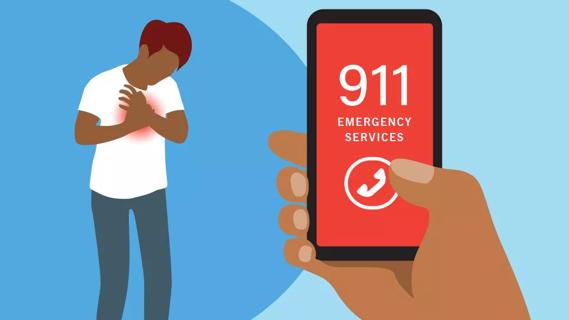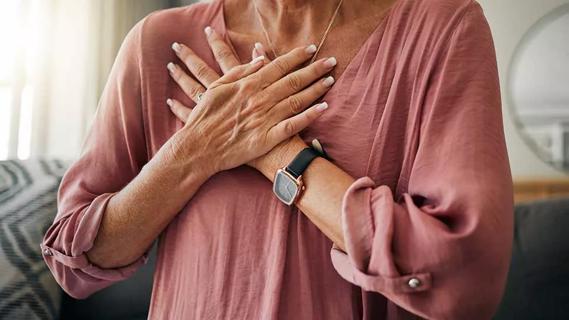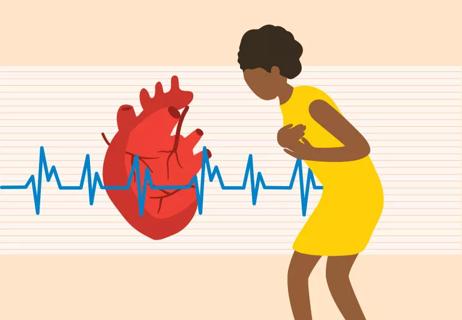Recognizing subtle symptoms, like cold sweats, stomach discomfort and nausea, could be the key to survival

Your body may be warning you about a heart attack. The question is, are you listening?
Advertisement
Cleveland Clinic is a non-profit academic medical center. Advertising on our site helps support our mission. We do not endorse non-Cleveland Clinic products or services. Policy
Some people experience early signs of a heart attack (myocardial infarction) in the day or hours leading up to a cardiac event — and those indicators may be much less obvious than you might expect.
Recognizing early heart attack symptoms could save your life or the life of someone around you, says cardiologist Jacqueline Tamis-Holland, MD. Here are the red flags that deserve your attention.
Heart attacks can be sudden and unmistakable, of course. A person may clutch their chest in pain, start sweating buckets and even collapse. (That’s probably what you typically imagine when you think of someone having a heart attack.)
But that’s NOT ALWAYS the case, clarifies Dr. Tamis-Holland.
In some people, heart attacks come on more gradually with signs that may not seem like an emergency. Early warning signs that can be easy to shrug off include:
“If you’re having some of these subtle symptoms of a heart attack and you don’t think you’re at risk for a heart attack, it makes it easier to ignore those warning signs and brush them off as something else,” says Dr. Tamis-Holland.
Advertisement
But ignoring these signs can be a life-threatening decision, she warns.
Heart attacks result from a blockage in one of the blood vessels in your heart, after all. A blockage means that blood can’t get to your heart. Without blood, your heart muscle begins to die.
If blood flow isn’t quickly restored, the result can be permanent heart damage or death.
Chest pain or pressure is the most common symptom of a heart attack, no matter your sex. It can feel like someone (or an elephant, to use a popular metaphor) is sitting on your chest.
But about 30% of women are more likely to experience less-obvious symptoms while having a heart attack, notes Dr. Tamis-Holland. That includes:
In addition, women are less likely to have that common chest pain feeling (particularly in the center of their chest) or indigestion-like discomfort.
These subtle signs are especially concerning given the heightened dangers that a heart attack brings to women. Research shows that women are more than twice as likely than men to die after a heart attack.
Certain conditions and lifestyle choices raise your risk for a heart attack. It’s best to be extra cautious if you experience vague heart attack symptoms and have:
But know this, too: Anyone, no matter their age, sex or health status, can have a heart attack. In fact, heart attacks are on the rise among young people under the age of 40.
If there’s even a chance you think you’re having a heart attack, act quickly to get emergency care. Without urgent treatment, heart tissue begins to die — and the damage could be irreversible.
“Time is muscle,” Dr. Tamis-Holland stresses. “The sooner your provider starts treatment, the better your outcome. Quick treatment can be critical for survival.”
If you believe you’re having a heart attack, it’s best to call 911 for emergency care (in the U.S.) instead of driving yourself. That’s because emergency responders can provide care on the way to the hospital and radio ahead so the ER is prepped for your arrival.
Every minute counts when you’re having a heart attack. Emergency crews starting care right away is vital when it comes to restoring blood flow.
What’s more, mild heart attack symptoms can swiftly turn severe. Some people faint or lose consciousness during a heart attack — a moment when you certainly don’t want to be behind the wheel.
Advertisement
And even if a loved one is driving you, it could be dangerous (and scary) for you both if your symptoms progress as you head to the hospital.
Bottom line? “When in doubt, err on the safe side and call 911,” Dr. Tamis-Holland advises.
Advertisement
Learn more about our editorial process.
Advertisement

Calling 911 or emergency services should always be your first step

Mild heart attacks may cause less damage, but they can still lead to serious complications and require medical attention

Congenital heart disease, genetic conditions and unhealthy lifestyle habits can put teens at higher risk for heart attack

Absolutely! In fact, in many ways, exercise is key to recovery

There’s no way to stop it once a heart attack is happening, but the most important thing you can do is to call for help

To help determine what you’re experiencing, focus on how the pain feels, the location of the pain, when it started and how long it lasts

Symptoms may be mild, but don’t be fooled — any heart attack is serious

Sedentary lifestyles are driving up heart attack numbers in the under-40 crowd

If you’re feeling short of breath, sleep can be tough — propping yourself up or sleeping on your side may help

If you fear the unknown or find yourself needing reassurance often, you may identify with this attachment style

If you’re looking to boost your gut health, it’s better to get fiber from whole foods